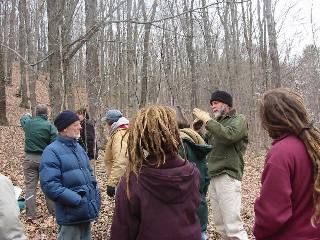
Permaculture
Introduction | Principles | Permaculture @ Ahimsa | Resources

The word "permaculture" was coined in 1978 by Bill Mollison, an Australian ecologist, and one of his students, David Holmgren. It is a contraction of "permanent agriculture" or "permanent culture." Permaculture is about designing ecological human habitats and food production systems.
The principles of permaculture design provide a set of universally applicable guidelines which can be used in designing sustainable habitats. Distilled from multiple disciplines�ecology, energy conservation, landscape design, and environmental science�these principles are inherent in any permaculture design, in any climate, and at any scale.
The Principles of Permaculture Design:
1. Relative location - Components placed in a system are viewed in relation to each other and the local environment, not in isolation.
2. Each element performs multiple functions; everything is connected to everything else.
3. Each function is supported by many elements. Good design has redundancy built in which ensures that all important functions can withstand the failure of one or more of its elements.
4. Energy efficient planning - Each element we include is a system, chosen and placed so that it performs as many functions as possible. Principle of Disorder - Disorder consumes energy to no useful end. Order and harmony produce energy for other uses. Tidiness is restrained disorder.
5. Using biological resources - Use and preserve biological intelligence. Use onsite resources; determine what resources are available and entering the system on their own and maximize their use.
6. Energy cycling - Do not consume or export more biomass than carbon fixed by the solar budget. Yields from system are designed to supply onsite needs and/or needs of the local region. Make least change for the greatest effect; the less change that is generated, the less embedded energy is used to endow the system. Aiding the natural cycles results in higher yield and less work. Whatever we take, we must return Every object must responsibly provide for its replacement. Hold water and fertility as high (in elevation) on the landscape as possible.
7. Small-scale intensive systems- start small and create a system that is manageable and produces a high yield.
8. Natural plant succession and stacking - Succession is when certain elements prepare the way for the system to support other elements in the future. stacking functions is attaining multi-level functions for single element. An example is multi-level garden design: annuals, ground covers, shrubs, trellised vines, under story and high tree crops.
9. Polyculture and diversity of species - As a general rule, as resilient systems mature they become increasingly diverse in both space and time. It is the complexity of the functional relationships that exist between elements which is important, not the number of elements.
10. Increase the "edge effect" within a system. Where two ecosystems come together a third forms which has more diversity than either of the other two. Tessellation increases edge.
11. Observe and replicate natural patterns. Use protracted & thoughtful observation rather than protracted and thoughtless labor. Stress and Harmony - Ecological stress may be defined as either prevention of natural function, or of forced function. Harmony may be defined as the integration of chosen and natural functions, and the easy supply of essential needs. The Problem is the solution; turn constraints into resources.
12. Pay attention to scale
13. Attitude - Keep a local focus - "Think globally - Act locally." Grow your own food; cooperate with neighbors. Community efficiency not self-sufficiency. Develop a policy of responsibility to relinquish power - The role of successful design is to create a self-managed system.
Permaculture Ethics:
- Care for the earth
- Care for the people
- Care for the future
Ahimsa Village hosted a Permaculture Design Workshop on April 5-7, 2006 on site. The class was taught by Mark Cohen. The result was a successful class and a pc plan for Ahimsa Village. Please contact Kelle Kersten at magicjubilee@yahoo.com if you are interested in learning more about the plan and/or would like to get involved in implementing it.
Our current projects include diversified community gardening and the PC orchard. Our gardens are a community effort, several members of Julian Woods Community assist in our gardening efforts. The focus of our gardening efforts is primary on working towards food self-sufficiency for the people living on the land trust; a secondary purpose is to provide food for the local community through local farmer's markets.
The PC orchard was a major undertaking in the spring of 2008. We planted 69 woody plants, 25 raspberries, and 100 strawberry plants. Our friend, Patty Ceglia, developed a comprehensive PC plan for the orchard. Patty has been trained in PC and has worked with Dawn Shiner of the School of Living. She teaches PC at Wilson College (Chambersburg, PA). Patty created guilds, sun traps, and swales. Many of her concepts are still in development. Eventually we plan to interplant annuals in the PC orchard. The woody plants were a mix of fruit and nut trees. We incorporated a number of native fruits into the plan. The PC orchard was supported by the Friends of Ahimsa Village. A complete list of plants are below:
Clove Currant, Am Black Currant, N Gooseberry, Tribute Strawberry, Cavendish Strawberry, Red Lake Currants, Pixwell Gooseberry, Red Raspberry, Adams Elderberry, John Elderberry, Lingonberry, Captivator Gooseberry, Hinnomaki Gold GB, BlueBelle Honeyberry, Bluebird Honeyberry, Apache Thlss Blackberry, Moorpark Apricot, Wenatchee Apricot, Jubilem Sour Cherry, Lapins Cherry, Hedelfingen Cherry, Ranier Cherry, Moonglow Pear, Clapps Favorite Pear, Stanley Plum, President Plum, Boyer McIntosh, Black Twig Apple, Granny Smith, Sops of Wine Apple, Wolf River Apple, Braeburn, Taylor Spur Rome B, Royal Medlar, Breda Giant Medlar, Green Gage Plum, Seneca Plum, Harko Nectarine, Canadice Grape, Himrod Grape, Dumbarton Oaks HK, DO HK Male, Wolfberry, Paw Paws, Persimmons, Robin Hill Juneberry, Meader Persimmon, Yates Persimmon, Dwarf Korean Chestnut, Michigan Pecan, Precocious Hazelnut, Precocious Hazelnut, Buartnut, Heartnut, All-in-One-Almond.
Permaculture is generally associated with green living efforts physically manifested on the land. At Ahimsa, we take a very holistic approach to permaculture. We are seeking the establishment of resilient structures in all aspects of living including spiritual, emotional, and psychological as well as physical. So in this respect Ahimsa is unique. We feel its equally, if not more, important to be developing sustainable personal and interpersonal relationships as well as developing resilient physical living strategies. In this light we are committed to practicing compassionate communication (using Marshal Rosenberg's Nonviolent Communication method as a guide), meditation, and yoga. In addition, we are committed to living lightly on the planet and actively work to develop physical living systems that mimic nature.
Below is our yearly cycle of activities:
Jan. - seed ordering, garden planning
Feb. - start of maple sugaring, pruning, seed starting
Mar. - sugaring, seed starting, equinox, celebration
Apr. - shiitake inoculation/harvest, transplanting
May - May Day, transplanting, wild salad gathering
June - corn planting, Solstice
July - garlic harvesting
Aug. - salsa making
Sept. - grain harvest, bread making in outdoor oven, apple
picking/preserving, Fall Equinox
Oct. - garlic planting, seed saving, apple picking/preserving, Harvest
dinner
Nov. - celebrate holidays from other cultures
Dec. - service projects, barter/sale of �stuff�, Winter Solstice
Resources
No Harm Farm: a planned service-oriented CSA farm with a
double bottom line - a successful business that addresses a social need.
Ahimsa Village Community
http://www.ahimsavillage.org
� 2006 - 2023
